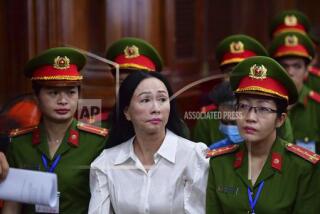Cambodia Can’t Afford Any Role for Pol Pot
- Share via
More than 5,000 Cambodians pushed and shoved to get seats when “The Killing Fields” opened in Phnom Penh earlier this month. They were curious to see this Hollywood version of the horror that they lived through under the Khmer Rouge regime of Pol Pot (1975-78). More than2 million Cambodians perished or fled the country during and immediately after that reign of terror; no family was untouched.
Pol Pot and his minions continue to exist --40,000 strong, well-armed, undeviating in their political goals--under Chinese patronage in jungle redoubts along the Thailand-Cambodia frontier. The Khmer Rouge even occupy Cambodia’s seat at the United Nations, in coalition with two factions led by Prince Norodom Sihanouk and Son Sann, head of the Khmer People’s Liberation Front. Their presence at the United Nations is largely due to the West’s displeasure at Vietnam’s 1978 invasion of Cambodia and its installation of a regime made up of Khmer Rouge defectors.
In Year Zero--1979--Cambodians lived in what we might imagine as a “post-nuclear” environment--without water, power, food, a monetary system and so on. Ten years later, there is a semblance of nervous normalcy about the country. The Vietnam-backed regime, led by Premier Hun Sen, has effectively rebuilt much of the destroyed infrastructure of Phnom Penh and large areas of the countryside.
Vietnam, so long isolated from Western aid and with 65 million mouths of its own to feed, has decided to call the West’s bluff and is rapidly pulling out the last of what was a 180,000-man army in Cambodia. Vietnam’s foreign minister, Nguyen Co Thach, says that it is now up to the West and the other Asian states neighboring Cambodia to guarantee that Pol Pot will not return to power.
The current Paris peace conference on Cambodia is deadlocked on key issues relating to the country’s future governance, to the resettlement of 350,000 refugees, and to disarming the Khmer Rouge without having to trade access to power.
Spoilers abound in and around the Paris talks. Congressman Stephen J. Solarz (D-N.Y.) pushed Congress to allow the Bush Administration to send lethal aid to Prince Sihanouk’s weak, 8,000-man army, even though it has shown virtually no capacity to effectively utilize what China has provided for 10 years. Son Sann’s faction accuses Vietnam of forcibly settling1 million Vietnamese in eastern Cambodia, in effect, colonizing that part of the country. Khmer Rouge spokesman and negotiator Khieu Samphan, an ultra-nationalist, seeks expulsion of all Cambodians of Vietnamese origin and the full integration of his troops into Cambodia’s national army.
In contrast to this dissension, there is something resembling unanimity in the approaches of the United States and the Soviet Union. Both want the Khmer Rouge excluded from participation in Cambodia’s governance unless they are fully disarmed and their top leadership retired in exile; both support elections and pledge to respect the outcome; both promise aid to Cambodia (the Soviets and Vietnam are Cambodia’s largest aid donors; the United States blocks all but emergency American humanitarian aid); both recognize the Cambodia issue as a major impediment to improved relations with China, and both are trying--slowly, in the American case--to defuse the tense atmosphere in Indochina and elsewhere in Southeast Asia.
There is virtual unanimity inside Cambodia against letting the Khmer Rouge back into anything approaching a legitimate role in Cambodian life. There is also almost abject fear of a civil war in which Pol Pot’s army apparently would be the strongest in the field.
The Hun Sen government in Phnom Penh has appealed to those countries present in Paris to press the Chinese to abandon their support of the Khmer Rouge. Phnom Penh could then invite the factions led by Prince Sihanouk and Son Sann to return to shared power, schedule elections and count on modest Western and Soviet Bloc military aid to allow them to contain a weakened Khmer Rouge. A United Nations peacekeeping force of at least 6,000 men would also be required to monitor a cease-fire if there is one.
This is not a perfect solution, nor is one likely to be found. The Khmer Rouge is unlikely to disarm under any formula; they are ultra-nationalists who will fight alone should China abandon them. Their leaders live under a death sentence imposed by Cambodian courts for genocidal offenses; their rank-and-file are 12- to 25-year-old young people who were trained to obey only their own leaders’ bizarre variant of Maoism. With the full cooperation of the Chinese and Thai governments, they could well be contained in their Cardamom Mountain retreats and left to wither away. That will take great resolve by the rest of the world, starting with the Soviet and American governments and their allies.
Given the sorry history of using Cambodia as a punching bag between Thailand and Vietnam for centuries; the wholesale violation of its borders by both Vietnam and the United States during the Indochina War, and the incalculably harsh American trade embargo imposed by Washington on Cambodia to punish and “bleed” Vietnam, there is something approaching an obligation by the rest of the world to guarantee Cambodia a future free of conflict and with no threat of a genocidal return of the Khmer Rouge.
More to Read
Sign up for Essential California
The most important California stories and recommendations in your inbox every morning.
You may occasionally receive promotional content from the Los Angeles Times.













